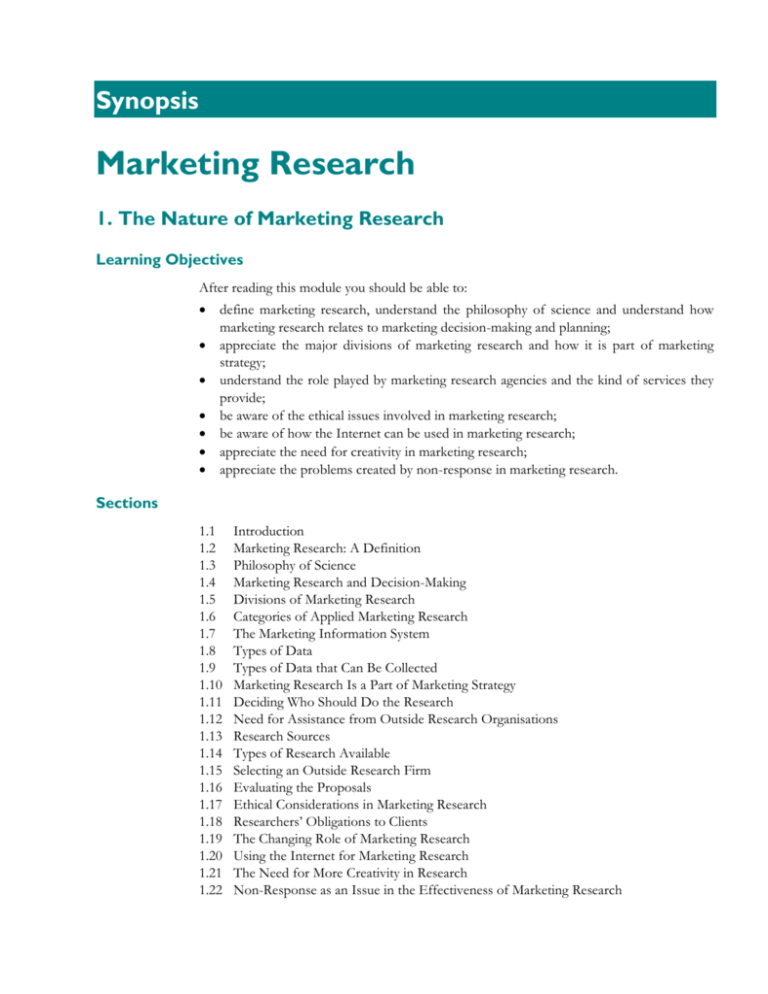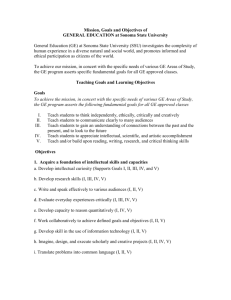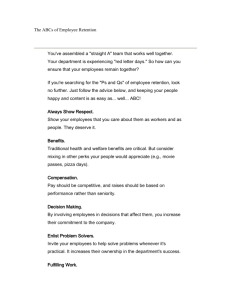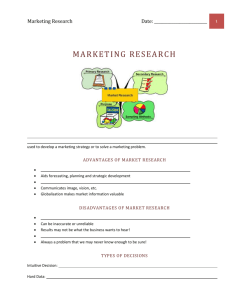Marketing Research - EBS Student Services
advertisement

Synopsis Marketing Research 1. The Nature of Marketing Research Learning Objectives After reading this module you should be able to: define marketing research, understand the philosophy of science and understand how marketing research relates to marketing decision-making and planning; appreciate the major divisions of marketing research and how it is part of marketing strategy; understand the role played by marketing research agencies and the kind of services they provide; be aware of the ethical issues involved in marketing research; be aware of how the Internet can be used in marketing research; appreciate the need for creativity in marketing research; appreciate the problems created by non-response in marketing research. Sections 1.1 1.2 1.3 1.4 1.5 1.6 1.7 1.8 1.9 1.10 1.11 1.12 1.13 1.14 1.15 1.16 1.17 1.18 1.19 1.20 1.21 1.22 Introduction Marketing Research: A Definition Philosophy of Science Marketing Research and Decision-Making Divisions of Marketing Research Categories of Applied Marketing Research The Marketing Information System Types of Data Types of Data that Can Be Collected Marketing Research Is a Part of Marketing Strategy Deciding Who Should Do the Research Need for Assistance from Outside Research Organisations Research Sources Types of Research Available Selecting an Outside Research Firm Evaluating the Proposals Ethical Considerations in Marketing Research Researchers’ Obligations to Clients The Changing Role of Marketing Research Using the Internet for Marketing Research The Need for More Creativity in Research Non-Response as an Issue in the Effectiveness of Marketing Research Learning Summary This module has explored how marketing research can take some of the risk out of marketing decision-making by providing information that can contribute to sound marketing decision-making. This may be achieved in all elements of the marketing-mix and, through involvement in problem formulation and solution-finding, marketing research becomes an integral part of the process of formulating marketing strategy. Marketing research can perform a variety of studies and makes use of both primary and secondary data sources. It can be applied either in-house or by marketing research companies that specialise in this form of consultancy. The latter offer a wide range of services, from off-the peg studies to tailor-made studies to meet the needs of individual clients. Like many other services involving the generation of confidential information and reports, ethical considerations are an important issue and need to be fully explored. New ways of asking questions pose challenges for marketing researchers and the introduction of creativity into marketing research is paramount. 2. Planning the Research Project Learning Objectives After reading this module you should be able to: understand how marketing research helps in allaying uncertainty; appreciate the cost and value of marketing research; appreciate the need to plan, schedule and control a marketing research project, probably with the aid of computer-based PERT in this process. Sections 2.1 2.2 2.3 2.4 2.5 2.6 2.7 2.8 2.9 2.10 2.11 2.12 2.13 2.14 2.15 Introduction Marketing Problems Continuous Monitoring for Problems Problem Definition: Goal-Oriented Approach Steps in Solving Problems Deciding Whether to Undertake a Research Study Uncertainty in Decisions Probable Pay-Off of Each Option Costs of Getting Information The Research Plan and Proposal Acquiring the Required Information The Questions Requiring Answers Planning in Advance for Analysis of Research Data The Proposal Use of PERT in Planning Research Learning Summary In this module it has been argued that marketing research performs a key role in helping to solve marketing problems and improve decisions. It achieves this by producing information that helps to allay uncertainty. The cost and value of marketing research, however, must be taken into account when deciding how much time and effort to expend on this activity. While the benefits of good information speak for themselves, the research has to be cost effective if it is to be used at all. Where the costs outweigh the benefits it is not desirable to undertake research. Marketing research projects are complex entities and require considerable planning, scheduling and control. This helps to coordinate a project and ensures that research information is produced within the specified period and cost specifications. Computer-based PERT network methods help to plan, schedule and control a project and facilitate savings in the cost and time required to complete the project. 3. Secondary Data Learning Objectives After reading this module you should be able to: appreciate the various sources of secondary data; understand how to start systematically to collect this data. Sections 3.1 3.2 3.3 3.4 3.5 3.6 3.7 Introduction Types of Secondary Data Searching For External Data How Secondary Data Can Be Used Other General Sources Professional Organisations and Libraries Using Secondary Data in Exploratory Research Learning Summary This module has considered the various sources of secondary data and suggested systematic ways of searching for appropriate data or information relevant to a marketing problem. Attention has been drawn to both government and commercial sources of data and to libraries, bibliographies, indexes and abstracts as important aids in the search for information process. Detailed information has been presented about many secondary information sources. 4. Sampling Learning Objectives After reading this module you should be able to: appreciate the key elements involved in devising a sampling plan; understand the important features of both probability and non-probability samples; understand the major types and primary practical uses of both probability and nonprobability sampling; understand the primary approaches for determining sample size; appreciate the nature of the sources of sampling and non-sampling error and how to minimise them. Sections 4.1 4.2 4.3 4.4 4.5 4.6 Introduction Sampling The Sampling Frame Sampling Methods Sampling In Practice The Size of the Sample Learning Summary This module has introduced the idea of sampling, contrasting it with a census. The key elements involved in devising a sampling plan have been discussed and the importance of properly defining the target population of interest has been emphasised. Illustrations of the important features of both probability and non-probability samples have been given and the major types and primary practical uses of both probability and non-probability sampling have been outlined. The primary approaches for determining sample size have been discussed and the concept of sampling and non-sampling error has been considered. The nature of the factors contributing to response and non-response errors have been described and suggestions made as to how response rates can be improved and non-response errors minimised. Particular attention has been given to sampling methods that are most appropriate for small populations. Attention has also been paid to the management of the sampling process and the determination of sample size. 5. Surveys Learning Objectives After reading this module you should be able to: appreciate the various approaches to collecting primary data through surveys: postal surveys, personal interviews, telephone surveys, completely self-administered surveys, panels and omnibus studies; understand the criteria used for selecting the data collection method best suited to the specific marketing research problem on hand; understand that, when using surveys to help answer a marketing problem, relevance, accuracy, timeliness and cost must be taken into account; appreciate the merits of different survey methods. Sections 5.1 5.2 5.3 5.4 5.5 5.6 5.7 5.8 5.9 Introduction Postal Surveys Personal Interviews Telephone Surveys Self-Administered Surveys Panels Syndicated Research Services Omnibus Studies Interactive Research Learning Summary This module has explored some of the various methods of collecting primary data through surveys: postal surveys, personal interviews, telephone surveys, completely self-administered surveys, panels and omnibus studies. The importance of and criteria for selecting the data collection method best suited to the specific marketing research problem have been considered. When using surveys to help answer a marketing problem, relevance, accuracy, timeliness and cost have to be taken into account. The module has discussed the merits of different survey methods, since each method has its own advantages and limitations. Attention has also been given to the use of panels, syndicated research services, omnibus studies and interactive research. 6. Measurement and Scaling Learning Objectives After reading this module you should be able to: appreciate the basic concepts of measurement and scaling; distinguish between the various types of measurement scales; describe and illustrate the comparative types of measurement scales; distinguish and illustrate the non-comparative types of measurement scales; appreciate the difference between single-item versus multiple-item scales. Sections 6.1 6.2 6.3 6.4 6.5 6.6 Introduction Measurement Scale Types Attitude Measurement Self-Reporting Methods Methods For Rating Attributes Learning Summary This module has defined and discussed the basic concepts of measurement and scaling, distinguishing among the various types of measurement scales. A description and illustration of comparative types of measurement scales have been given, as have descriptions and illustrations of non-comparative types of measurement scales. Single-item versus multipleitem scales have been compared and discussed. Various attitude measurement scales have also been examined. 7. Questionnaires Learning Objectives After reading this module you should be able to: understand the principles involved in designing and constructing questionnaires; understand the principles involved in testing and debugging questionnaires. Sections 7.1 7.2 7.3 7.4 7.5 7.6 Introduction Structure of the Questionnaire Stages in the Development of A Questionnaire Questionnaire Design and Construction Introducing a Questionnaire Reliability and Validity in Questionnaire Design Learning Summary Questionnaire design is a craft. Many factors have to be taken into account when assembling a questionnaire. These include such things as the overall research objectives, the kinds of data analysis that are to be employed, the amount of money that can be spent on the research project and the time in which the research has to be completed. There are no hard and fast rules about designing a questionnaire but there is a set of guidelines that can be followed to help overcome the risk of poor questionnaire design. In this module we have examined issues in questionnaire design and construction. The major activities involved in questionnaire design are: (1) preliminary considerations, (2) question content, (3) question phrasing, (4) types of response format, (5) question sequence, (6) questionnaire layout, and (7) pretest, revision and final version of the questionnaire. The discussion emphasised general guidelines and suggested basic principles involved in asking questions. For questionnaire construction, attention was focused on response formats, logical flow and layout considerations. In discussing the pretesting of questionnaires emphasis was placed on what items should be pretested, the manner in which the pretest should be conducted, who should be the respondents in the pretest, and how large a sample is required for the pretest. Finally, attention was paid to establishing the reliability and validity of questionnaires. 8. Qualitative Research Learning Objectives After reading this module you should be able to: understand the nature and uses of focus groups; understand the possible misuse of focus groups; appreciate the techniques used in moderating group discussions; understand the difference between focus groups used for consumer-product research and those used for industrial research. Sections 8.1 8.2 8.3 8.4 8.5 8.6 8.7 8.8 8.9 Introduction Focus Groups Types of Focus Groups Other Group Research Methods The Moderator Preparation The Interview Industrial Focus Groups Other Qualitative Research Methods Learning Summary This module has examined the nature and uses of focus groups, showing how this method of data collection can obtain information that is largely unavailable through other types of marketing research. Advice has been offered about the possible misuse of focus groups, and details of the techniques used in moderating group discussions have been described. The distinction between focus groups used for consumer-product research and those used for industrial research has been made. Attention has also been drawn to a variety of other qualitative research techniques, notably those relying on projective methods. Finally consideration has been given to a new way of collecting qualitative data through the medium of electronic interviews. 9. Observations and Experiments Learning Objectives After reading this module you should be able to: understand the role played by observational techniques in marketing research; appreciate how experimentation can be applied in marketing; understand the function and limitation of different experimental designs; understand the different kinds of approaches that can be taken to test-marketing. Sections 9.1 9.2 9.3 9.4 9.5 9.6 9.7 9.8 Introduction Observation Experiments Impact of Extraneous Factors Experimental Designs Statistical Designs Test-Marketing: An Introduction Consumer-Tracking Studies Learning Summary This module has examined a variety of observational methods including those using mechanical means and scanning. It has also looked at experimentation as a research method. Different types of experimental design have been examined, together with a discussion of their limitations, as well as a variety of approaches to test-marketing. 10. Quantitative Data Analysis Learning Objectives After reading this module you should be able to: understand how to identify meaningful patterns in research data; understand how to convert into tables data collected with research instruments; understand how to code questions; understand how to analyse data with statistical methods; appreciate how the computer can be used to transform and facilitate the interpretation of research data. Sections 10.1 10.2 10.3 10.4 10.5 10.6 10.7 10.8 10.9 10.10 10.11 10.12 10.13 10.14 Introduction Interpretation Analysis Tabulation Editing Coding Statistical Treatment: Giving Meaning to Survey Numbers Measures of Location Measures of Dispersion Hypothesis Testing Chi-Square Analysis Use of Similarities Between Numbers to Show Cause and Effect Analysis of Variance Measuring Relationships Learning Summary This module has examined how research results can be analysed and interpreted to establish meaningful patterns. The steps involved in converting completed research instruments into tables has been examined, together with the coding of answers to questions and the statistical treatment of survey data. Attention has been given to the role of the computer in transforming and facilitating the interpretation of research data. Specific topics covered include the cross-tabulation of data, correlation and regression. Multivariate analysis of variance has also been covered, together with other multivariate techniques such as multiple regression analysis, cluster analysis, factor analysis, conjoint analysis and multidimensional scaling. 11. Qualitative Data Analysis Learning Objectives After reading this module you should be able to: understand the general overall approach to qualitative analysis; appreciate the types of computer programs that may be used to help in the process of categorisation and other aspects of qualitative research; understand how to improve data display; convey meaning in the analysis through the use of matrices, networks and diagrams. Sections 11.1 11.2 11.3 11.4 Introduction Qualitative Analysis Operational Aspects of Qualitative Research Data Displays Learning Summary In this module we have examined the general overall approach to qualitative analysis, a key aspect of which involves transcribing what has been said or otherwise recorded and then undertaking a detailed analysis of the transcribed written text. This involves searching for key words and phrases and categorising sections of text. Methods for doing this have been reported in the module, together with types of computer programs that may be used to help in this process. In quantitative research, tables and graphs are used to display data and convey meaning in the analysis. In qualitative analysis the same effect may be achieved with the use of matrices and networks. The module has given some examples of these tools. In the case of networks, attention has also specifically been given to the construction of causal diagrams that can do much to help in the interpretation of findings. 12. Evaluating, Reports and Presentation Learning Objectives After reading this module you should be able to: understand the importance of the presentation to the success of a research study; appreciate the preparation of different aspects of the presentation; understand how to use some of the visual and electronic aids that are available to the presenter. Sections 12.1 Introduction 12.2 Evaluation of Research 12.3 The Written Report 12.4 The Sections of a Report 12.5 The Oral Research Report 12.6 Visual Aids and Their Use Learning Summary This module has examined the importance of the presentation to the success of a research study. It looked at the preparation of the different aspects of the presentation and concluded with a discussion of some of the visual and electronic aids that are available to the presenter. 13. Applied Marketing Research Learning Objectives After reading this module you should be able to: understand how marketing research may be applied to specific areas of marketing. Sections 13.1 13.2 13.3 13.4 13.5 13.6 13.7 13.8 13.9 13.10 13.11 13.12 13.13 13.14 Introduction Product Research Getting Ideas for New Products Product Delivery Naming the Product Packaging the Product Market Segmentation Research Cartographying Geographic Segmentation Competition Research Promotion Research Measuring Advertising Effectiveness Selling Research Pricing Research Distribution Research Learning Summary This module has examined several applied areas of marketing research: product research, segmentation research, competition research, promotion research, pricing research and distribution research. In the case of product research, attention has been paid to product generation and testing, consumer product testing and packaging research. In the case of segmentation research, attention has been given to researching ways of segmenting the market. In promotion research, attention has been focused on the ways of assessing its suitability and effectiveness, and various approaches to pricing research were examined. Finally, attention was paid to some aspects of distribution research. 14. Marketing Research Settings: Business-To-Business, Services and Internal Marketing Learning Objectives After reading this module you should be able to: understand the differences and similarities between consumer marketing research and business-to-business marketing research; appreciate how marketing research can be applied to the marketing of services; have an understanding of the concept of internal marketing and the role that can be played by marketing research within such a context. Sections 14.1 14.2 14.3 14.4 14.5 Introduction Business-To-Business Marketing Research Research Into Services SERVQUAL Research for Internal Marketing Learning Summary The module has examined business-to-business marketing research and internal marketing research. In the case of business-to-business marketing research the differences and the similarities with consumer marketing research have been explored. Business-to-business marketing research has changed considerably in recent years and employs many of the approaches that were at one time the domain of consumer research. Service marketing research includes shopping surveys. In a shopping survey, a field worker poses as a customer and, following a list of predefined steps, makes mental notes. Major users of such surveys are retailers and hotels. Such studies are generally handled by an outside specialist firm. It also makes use of customised, full-scale studies of service satisfaction to provide measurement of customer reactions to the delivery of service. Other customer/client reaction studies are often used by small-scale retailers or service firms as well as by the larger firms. Parasuraman et al. published their now classic article which led to a revolution in the way that service quality is dealt with. In that paper the results of their exploratory research were presented, including a statement of ten service quality determinants that appeared to be relevant. In order to improve ‘true quality’ in a service organisation the first step is to identify the quality determinants most important or relevant to the company’s target market and then assess their own and their competitors’ performance. This early work formed the basis for the development of SERVQUAL. Internal marketing is based upon the idea that every individual in an organisation, particularly a service organisation, should recognise that they have customers to serve. There is a positive link between internal service quality and external service quality and hence customer satisfaction, customer loyalty and the profitability of the organisation. Market research can be adopted for use with employees. Personnel can be given the opportunity to give feedback to management about working conditions, company policy in general and workers’ own understanding about what comprises quality for the customer. The relationships between organisational sub-units and their relationship to top management are also important. This can be assessed by a variation of the SERVQUAL instrument mention above. 15. Global Marketing Research Learning Objectives After reading this module you should be able to: appreciate how marketing research is organised and conducted in global markets; understand how global marketing research may differ from research in the home market. Sections 15.1 15.2 15.3 15.4 15.5 Introduction Global Marketing Research Desk Research Principal Methods of Organising Research Marketing Research in Developing Countries Learning Summary Emphasis has been placed on how marketing research is organised and conducted in global markets. Desk research is an important source of information and attention has been given in the chapter to identifying fruitful sources of information. There are additional difficulties involved in undertaking marketing research in developing countries and the situation is also worsened by a lack of requisite research skills and a poor appreciation of the value of marketing research. Often, few indigenous organisations possess marketing research departments and comparatively few commercial marketing research services exist. 16. Marketing Decision-Support Systems Learning Objectives After reading this module you should be able to: appreciate the nature of marketing decision-support mechanisms; appreciate, in particular, the use of traditional management science and operational research tools in marketing. Sections 16.1 16.2 16.3 16.4 Introduction Marketing Information Systems Decision-Support Mechanisms Forecasting Demand 16.5 Applications for Mathematical Models in the Marketing Decision-Support System 16.6 Expert Systems and Decision Support Learning Summary Marketing information systems exist to help marketing managers get to grips with the volumes of data with which they are constantly bombarded. The marketing information system provides management with a variety of reports to help its decision-making. Marketing planning requires the size of current and potential markets to be carefully measured and estimated. There are several approaches to forecasting. Some methods rely on asking questions of people, while others involve the statistical analysis of historical data. An indication and examples of how management science/operational research techniques and tools can be applied to marketing problems is given. Methods considered included linear programming, transportation models, assignment models, network models, decision trees, inventory models, queuing theory models, Markov analysis, simulation and game theory. A growing area of interest and importance in the area of decision-support systems are expert systems. There are many opportunities for the implementation of expert systems in marketing.






